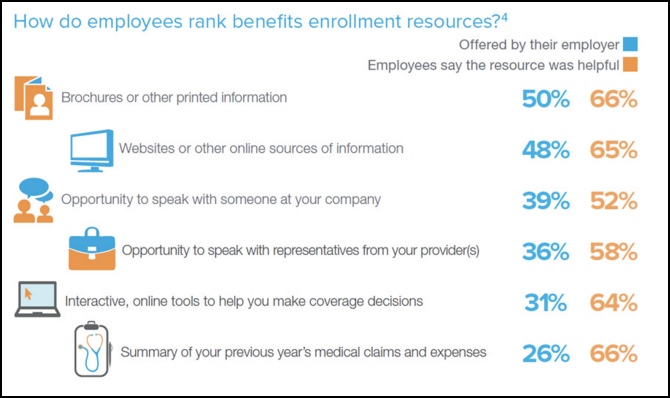Blog
How Video is Revolutionizing Employee Benefits Open Enrollment
Technology is creeping into and disrupting every area of businesses today. Most of us can probably agree that technological advances, after a ramping-up period, aim to make things more efficient, more convenient and more cost effective. They open our eyes to new possibilities of the way we operate as a business. And the human resources and employee benefits sectors are no different.
[caption id="attachment_6741" align="alignnone" width="900"] Person using e-learning website on mobile phone[/caption]
Person using e-learning website on mobile phone[/caption]
Consider this: http://info.shiftelearning.com/blog/bid/301248/15-Facts-and-Stats-That-Reveal-The-Power-Of-eLearning
- According to a Brandon-Hall study, e-learning takes up to 60 percent less employee time than a traditional classroom setting
- E-learning increases retention rates up to 60 percent versus the 10 percent retention with in-person training, according to the Research Institute of America
- A 2013 statistic showed 42 percent of the Fortune 500 already incorporate e-learning for employee training
Those statistics are compelling. And these trends have the opportunity to completely disrupt the conventional approach to employee benefits communication and open enrollment for employees.
Let’s look at this closer.
How It’s Always Been
Over the past 20 or 30 years, open enrollment and benefits education meetings have followed the same format. These meetings have largely depended on representatives either traveling to a company, or in-house employees taking time from their day to conduct a meeting.
The meetings typically consist of PowerPoint presentations or group interaction, where the presenters essentially throw everything but the kitchen sink at employees in a short period of time.
The people in the audience usually have different levels of knowledge about the topic or are interested in different things. This causes folks to tune out at different periods throughout the meeting, and not be engaged.
Remembering that not everyone will show up to the meetings in the first place, and those who do undoubtedly have more important work to do. Those who tune out usually reach out to the representative at a later time with their individual questions, which is less inefficient than addressing it up front.
Time and time again, we see employee confusion about benefits plans and what they mean, despite the conventional training we continue to perpetuate. (Forty-four percent of employees said they don’t understand their policies, according to this 2015 survey by Aflac).
This adds up to a lot of wasted time for businesses. Not to mention the costs of training.
And as a business, you want to make sure your employees are getting the most from their benefits. With open enrollment around the corner, we're discovering a new way to use technology that we think is going to improve how we communicate benefits to employees.
How It’s Changing
The digitization of employee benefits enrollment has become second nature over recent years. The Aflac survey found that online enrollment increased from 42 percent in 2011 to 62 percent in 2015.
The survey also showed that 64 percent of employees found interactive online tools to help them decide on coverage was helpful, but only 31 percent of employers offered it.
At Woodruff Sawyer, we’re experimenting with digital training, and it’s got a lot of potential.
Video training on employee benefits allows companies to:
- Tailor an engaging and consistent message
- Invite employee spouses to participate in the same way
- Provide a self-paced learning environment
- Cater to different interests and levels of knowledge
- Offer an interactive format with links throughout to explore more information
- Save on the overall costs of conventional training and meetings
As technology becomes more accessible, the costs of incorporating custom videos for this type of venture goes down, sometimes as low as $4,000 per video.
Compare that with the millions in the total costs that some companies pay to provide and administer employee benefits, and the barrier to entry for this new technology now seems almost nonexistent.
At Woodruff Sawyer, we’re beginning to incorporate technology in this way for employee benefits communication. We’re currently testing the results and outcomes, and will update readers as we begin to collect more data.
What You Can Do
If you’re interested in incorporating video training into your employee benefits communication and open enrollment, here are some things to consider.
First, explore your vendor choices. We’ve used VideoMundo, GuideSpark and Benefitfocus, but there are others on the market. When selecting a vendor, look for:
- Video communications consulting expertise
- A level of customization
- Sound production project management
- Service guarantees
- Finished product examples
Companies that use video training can expect to have some upfront work in the vision and messaging of the video content, just as you would any other training format. After that, the training essentially runs itself.
Of course, you’ll still want to have representatives who are available to answer employee questions at any time in a variety of communication formats (online, phone or face-to-face). And these questions may be around how to use the technology itself—not just the benefits.
For the generations that prefer the traditional methods of open enrollment, have that available as a Plan B.
For example, the Aflac survey showed 45 percent of the Silent Generation used online enrollment, but 25 percent preferred face to face. This may indicate the desire to have an in-person meeting for benefits versus a video, so be prepared.
The goal is to offer a variety of training formats that resonate with the majority but cater to the minority as well.
In terms of the time investment involved in video versus in-person training, after the videos are produced, you may only need to make slight modifications to them the next open enrollment period as things change. This effectively keeps your resources open and available for other things.
Employees want to take charge of their healthcare, and in order to be better consumers, they need the training and resources to help them to do that.
While the transition from traditional in-person training to technology may be a barrier in itself for some companies, the move can pay dividends in the long run, saving companies time and money, and instilling confidence in your employees’ choices.
Table of Contents













